Viruses are one of the oldest organisms on Earth. They consist simply of a protein envelope and nucleic acids, which renders them unable to replicate outside of a host. Some viruses, such as influenza, can both rearrange compatible genes and mutate on a regular basis in order to remain invisible.[1]
Interestingly, the main benefit of herbs is their working relationship with our own innate ability to ward off pathogens, such as viruses. This in part is what makes herbal medicine so unique. Although herbs provide some direct anti-viral activity, they primarily act in a non-specific, adaptive manner.
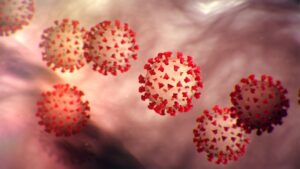
Coronaviruses are positive-stranded RNA viruses, which allows them to reproduce their proteins and genomes directly in the cytoplasm. Of all RNA viruses, they possess the largest genome. From the seven coronavirus species that infect humans that are currently identified, SARS-CoV-2 has the highest reproductive number.[2]
From Mild to Life-Threatening: The Many Faces of COVID-19
While the majority of COVID-19 cases are mild or asymptomatic, for some people, the virus turns life threatening. Dysregulated immune response and cytokine-release syndrome, due to overactivation of innate immunity characterize the presentations of severe COVID-19.[3] Obesity together with lymphopenia (low lymphocytes) are factors that can predict a poor prognosis in patients with COVID-19.[4]
Advanced SARS-CoV-2 infected patients generate inflammatory cytokines and chemokines in response to the virus, such as interleukin-1 beta (IL-1), IL-6, and IL-18. This is referred to as a cytokine storm, which can then manifest as sepsis. The immune response triggers activation of the Nod-like receptor family, pyrin domain-containing 3 (NLRP3) inflammasome pathway, and then in turn, release of its products, including the proinflammatory cytokines IL-6 and IL-1.[5]
While antibiotic therapy is commonly prescribed in cases of sepsis to prevent a relapse, clinical immunosuppressive treatments for the SARS-CoV-2 associated acute respiratory failure and resultant sepsis have not been very effective. Recently, however, the use of steroids for patients on ventilators reduced the death rate from 1 out of 10 to 1 out of 5. Steroids showed no benefits for patients not on ventilators.[6]
The limited success could be attributed to the very high specificity of drugs tested. The cytokine storm they try to inhibit involves multiple branches of the immune system across a wide range of signaling pathways, while broad range immunosuppression has been shown to worsen SARS-CoV-2 infection prognosis in transplant patients.[7],[8]
This group of viruses, having a very high frequency of recombination, constantly produce new variations. This is part of the challenge from an allopathic modern pharmaceutical perspective, but not really from an herbal (botanical) one. Plants are living, are God created (I often call them “smarty plants”) and have built complex networks that are adaptive and communicate with our physiological responses. Herbal medicines help to optimize our responses, first by helping us to be more efficient in our immune response to a virus, and second in combating the virus itself. This is essential to understanding the value and difference of herbal medicine from all other forms of medicine.
Both SARS-CoV and the new SARS-CoV-2 are responsible for acute respiratory failure. In addition to the typical presentation of respiratory distress, about 25% of infected cases also develop acute digestive problems.[9]
SARS viruses attach to ACE-2 on the surface of lung, lymph and spleen epithelial cells. As a consequence of angiotensin converting enzyme 2 (ACE-2) damage after a SARS viral infection, the renin-angiotensin system is down regulated, causing a decrease in oxygen saturation in the lungs and pulmonary hemodynamics.[10],[11]
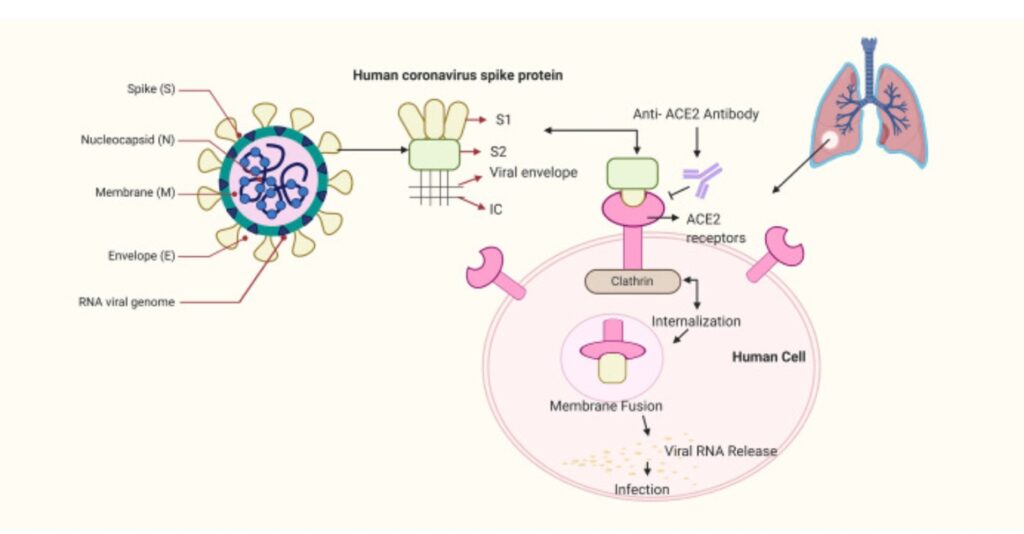
Structure and Binding of COVID-19 Virus to ACE2
The figure above depicts the structure of the COVID-19 virus. Among the viral structure, the S protein has a major role in binding the virus to the host receptor cells.[12]
Herbal medicines can help to fight a viral infection in many direct ways, although I still consider this secondary. Herbal medicines possess an ability to block the SARS virus from binding to ACE-2, while simultaneously increasing ACE-2 activity and expression, and have been shown to modulate the inflammatory cytokines levels, most notably IL-1 and HMGB1. The adaptability of herbal medicines to various protein-inhibitory roles could be in part due to a shared glycan-mimicking structure of plant based phenolic compounds.[13]
Research on Herbal Medicines and their Role in Combatting Acute Viruses
Withania somnifera (Ashwagandha)
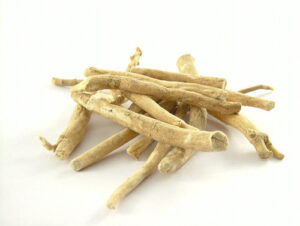
The primary adaptogen and traditional Indian medicinal plant Withania somnifera (ashwagandha) contains natural constituents called withanolides, which are the main active compounds responsible for the health promoting effects of the plant.
The main protease (Mpro) of SARS-Co V-2 plays a vital role in disease propagation by processing the polyproteins that are required for its replication. A recent study found that withanoside V in ashwagandha may be a potential inhibitor against Mpro of SARS-CoV-2 to combat COVID-19 and may have an antiviral effect on nCoV.[14]
Rhodiola Rosea
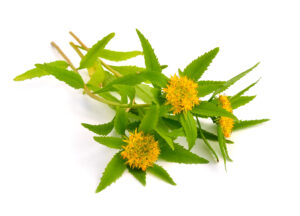
Rhodiola extract, rich in the active compound salidroside, has demonstrated positive effects against sepsis-induced acute lung injury mediated by the inhibition of inflammatory responses and HMGB1 production in bacterial LPS-treated macrophages. Salidroside was shown to alleviate sepsis-induced lung edema, lipid peroxidation, and histopathological changes and mortality.[15]
Panax Ginseng
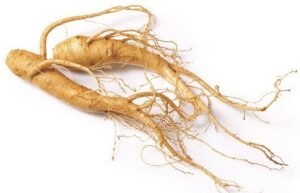
Panax ginseng, rich in ginsenosides, is another adaptogenic herb with potent anti-inflammatory effects. The antiseptic activity of ginsenoside Rh1 (one of the main active constituents of the ginseng root extract) has been noted in mice. Ginsenoside Rh1 increased the survival rate in a mouse sepsis model. It also significantly reduced HMGB1 release in LPS-activated HUVECs.[16]
In studies, ginseng extract significantly protected mice in experimental sepsis by decreasing TNF-alpha, IL-1, and IL-6 production via inhibition of NF-kB activation.[17]
The direct anti-viral function of ginseng has also been proven against influenza strain H1N1. When administered topically to the viral infection site intranasally, ginseng interacted with viral hemagglutinin and prevented the virus from attaching to host sialic acid receptors.[18]
Eleuthero (Acanthopanax senticosus)
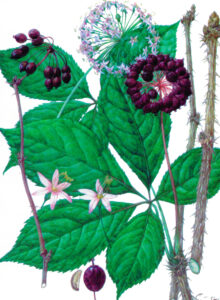
Eleuthero, previously called Eleutherococcus senticosus (or Siberian ginseng), was the most researched herb in Russia for over three decades.
Eleuthero fluid extract has an overall tonic effect and immune-enhancing anti-viral effect, including antiviral activity against a wide range of respiratory viruses. There is a substantial amount of human research on eleuthero and its beneficial effects on the immune system, both in chronic diseases such as cancer and acute infectious diseases.[19]
In studies, eleuthero fluid extract inhibited the replication of human rhinovirus (HRV), respiratory syncytial virus (RSV) and influenza A virus in cell cultures infected with these viruses, all of which belong to the RNA type viruses. Analysis of virus production after treatment of the infected cells using plaque-reduction assays showed a strong antiviral activity of the Eleutherococcus s. extract. In contrast, no effect was detected using the same protocol for cells infected with the DNA viruses, adenovirus (Adeno 5) or herpes simplex type 1 virus (HSV 1). The results of the study demonstrate that the Eleutherococcus extract inhibited the replication of all RNA viruses studied so far. This antiviral activity remained stable under the conditions used for drug preparation and storage.[20]
Animal studies have demonstrated that eleuthero extract has a direct capacity to induce interferon, in the presence of viral attack.[21]
The ability of eleuthero to consistently inhibit the flu and other infections is likely to do with its ability to respond to viral attack by inducing an anti-viral immune response including the production of interferon.[22]
Eleutheroside B1, a coumarin compound extracted from Eleuthero root, has been shown to exhibit antiviral and anti‑inflammatory activities against influenza A virus.[23]
The transcriptomic responses of influenza A virus‑infected lung epithelial cells (A549) treated with eleutheroside B1 were investigated using high‑throughput RNA sequencing, and potential targets were identified using a molecular docking technique, reverse transcription‑quantitative polymerase chain reaction (RT‑qPCR) assay, and DNA methylation analysis. Eleutheroside B1 affected N‑glycan biosynthesis, the chemokine signaling pathway, cytokine‑cytokine receptor interaction and targeted the POLR2A inhibiting the production of influenza virus gene.[24],[25],[26]
Additional Herbs for Symptom Relief
In the event of viral infection, relieving symptoms is paramount. Some of my favorites include the following:
Elecampane (Inula helenium)
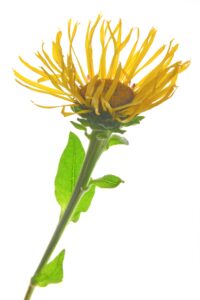
I consider elecampagne the best tonic herb for the lungs. Elecampane root (Inula helenium) “has an extended historical use for treatment of colds, flu, respiratory, fungal/bacterial/parasitic infections, pain, animal bites and skin ailments.”[27] It not only relieves coughs, but it is also rejuvenating and strengthening for the entire respiratory system.
Combined with adaptogens, elecampane is helpful for the person who tends to develop bronchitis or pneumonia during the winter months. In Chinese medicine and Native American traditions, elecampagne is used for respiratory conditions including bronchitis and tuberculosis. Chinese medicine prescribes elecampane as an expectorant, antitussive, diaphoretic, and bactericidal.
The Eclectic physicians valued elecampagne for bronchial coughs with copious phlegm and considered the herb especially beneficial for children. The high mucilage content elicits a relaxing effect on the respiratory system, while the essential oil compounds stimulate the expulsion of mucus. In this way, expectoration is accompanied by a soothing action, and the herb also has an anti-microbial effect. Ellingwood considered elecampane to, “act directly upon the nutritive functions of the body” and to “impart tone to the digestive and respiratory organs and to the urinary tract.” [28]
The main active compound in elecampane is alantolactone, which shows significant suppression of IL-8, TNF-alpha, and IL-1-beta release during chronic upper respiratory infections.[29] Extracts of elecampane have been shown to inhibit NF-kB activity, numerous inflammatory cytokines, and HMGB1 release, and also to significantly suppress expression of intracellular and vascular adhesion molecules.[30]
This research suggests that elecampane reduces lung inflammation and lung damage caused from acute pathogenic diseases.
Lonicera spp.
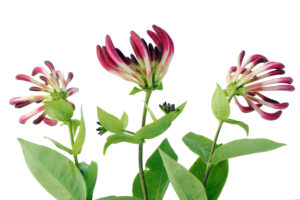
Lonicera, along with forsythia, are the most commonly used herbs in Traditional Chinese medicine and are classified among those that clear heat and toxins. At the turn of the 20th century, lonicera was used in the treatment of acute infections, including colds and flu.[31] In vitro and animal studies (primarily testing for influenza) indicate antibacterial and antiviral activity.[32],[33]
Lonicerin, the active compound in lonicera, has potent anti-inflammatory effects. This has proven beneficial in calming the excessive immune response that results in diffuse damage of lung cells (pulmonary fibrosis).[34] In a recent study, mice with septic conditions treated intravenously with lonicera experienced decreased levels of cytokines such as TNF-alpha, IL-1-beta, and HMGB-1 in the blood.[35],[36]
Andrographis paniculata
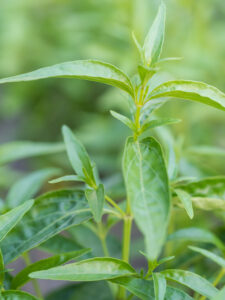
Andrographis is often referred to as the ‘King of Bitters.’ Andrographolide is a potent anti-inflammatory diterpenoid lactone isolated from andrographis, which has been effectively used for the treatment of infection, inflammation, cold, fever and diarrhea in China for centuries.[37]
Andrographis is used for treating viral respiratory infections in Ayurvedic and other medicinal systems.[38],[39] Research shows that Andrographis paniculata suppresses increased NLRP3, caspase-1, and interleukin-1β molecules, which are extensively involved in the pathogenesis of SARS-COV and likely SARS-CoV-2 as well.[40],[41] Several recent studies have demonstrated andrographis to be an effective remedy against the common cold.[42]
As we work to understand how to best protect ourselves against viral infections, I am convinced that herbs are one of our best resources. Medicinal plants act in various ways to help us ward off or overcome viruses. Ideally, we use adaptogens on a daily basis to support our immune systems and bolster our innate ability to deflect pathogens. Should a virus take hold, herbs offer a multitude of pathways to support healing in a gentle, supportive manner.
(Banner credit to Sheri Amsel)
[1] Ghenkina, D.B.; Ghendon, Y.Z. Recombination and complementation between orthomyxoviruses under conditions of abortive infection. Acta Virol. 1979, 23, 97–106.
[2] Petrosillo, N.; Viceconte, G.; Ergonul, O.; Ippolito, G.; Petersen, E. COVID-19, SARS and MERS: Are they closely related? Clin. Microbiol. Infect. 2020, 26, 729–734.
[3] Tian, S. et al. Pulmonary pathology of early-phase 2019 novel coronavirus (COVID-19) pneumonia in two patients with lung cancer. J. Thorac. Oncol. 15, 700–704 (2020).
[4] J.M. Urra, C.M. Cabrera, L. Porras, I. Ródenas, Selective CD8 cell reduction by SARS-CoV-2 is associated with a worse prognosis and systemic inflammation in COVID-19 patients, Clinical Immunology, Volume 217, 2020, 108486, ISSN 1521-6616, https://doi.org/10.1016/j.clim.2020.108486
[5] Tracey L. Freeman and Talia H. Swartz, Targeting the NLRP3 Inflammasome in Severe COVID-19, Front. Immunol., 23 June 2020, https://doi.org/10.3389/fimmu.2020.01518
[6] Walker, Molly, Finally: Common Drug Improves COVID-19 Survival in Trial | MedPage Today, 6/16/2020, https://www.medpagetoday.com/infectiousdisease/covid19/87086?xid=nl_popmed_2020-06-16&eun=g1065123d0r&utm_source=Sailthru&utm_medium=email…
[7] Gupta, A., Madhavan, M.V., Sehgal, K. et al. Extrapulmonary manifestations of COVID-19. Nat Med 26, 1017–1032 (2020). https://doi.org/10.1038/s41591-020-0968-3
[8] Kronbichler, A., Gauckler, P., Windpessl, M. et al. COVID-19: implications for immunosuppression in kidney disease and transplantation. Nat Rev Nephrol 16, 365–367 (2020). https://doi.org/10.1038/s41581-020-0305-6
[9] Xu, Y.; Li, X.; Zhu, B.; Liang, H.; Fang, C.; Gong, Y.; Guo, Q.; Sun, X.; Zhao, D.; Shen, J.; et al. Characteristics of pediatric SARS-CoV-2 infection and potential evidence for persistent fecal viral shedding. Nat. Med. 2020, 26, 502–505.
[10] Imai, Y.; Kuba, K.; Penninger, J.M. The discovery of angiotensin-converting enzyme 2 and its role in acute lung injury in mice. Exp. Physiol. 2008, 93, 543–548.
[11] Jia, H. Pulmonary Angiotensin-Converting Enzyme 2 (ACE2) and Inflammatory Lung Disease. Shock 2016, 46, 239–248.
[12] Vellingiri B, Jayaramayya K, Iyer M, et al. COVID-19: A promising cure for the global panic. Sci Total Environ. 2020;725:138277. doi:10.1016/j.scitotenv.2020.138277
[13] Wyganowska-Swiatkowska M, Nohawica M, Grocholewicz K, Nowak G. Influence of Herbal Medicines on HMGB1 Release, SARS-CoV-2 Viral Attachment, Acute Respiratory Failure, and Sepsis. A Literature Review. Int J Mol Sci. 2020;21(13):E4639. Published 2020 Jun 30. doi:10.3390/ijms21134639
[14] Tripathi MK, Singh P, Sharma S, Singh TP, Ethayathulla AS, Kaur P. Identification of bioactive molecule from Withania somnifera (Ashwagandha) as SARS-CoV-2 main protease inhibitor [published online ahead of print, 2020 Jul 8]. J Biomol Struct Dyn. 2020;1-14. doi:10.1080/07391102.2020.1790425
[15] Lan, K.-C.; Chao, S.-C.; Wu, H.-Y.; Chiang, C.-L.; Wang, C.-C.; Liu, S.-H.; Weng, T.-I. Salidroside ameliorates sepsis-induced acute lung injury and mortality via downregulating NF-_B and HMGB1 pathways through the upregulation of SIRT1. Sci. Rep. 2017, 7, 1–11.
[16] Lee, W.; Cho, S.-H.; Kim, J.-E.; Lee, C.; Lee, J.-H.; Baek, M.-C.; Song, G.Y.; Bae, J.-S. Suppressive E_ects of Ginsenoside Rh1 on HMGB1-Mediated Septic Responses. Am. J. Chin. Med. 2019, 47, 119–133.
[17] Lim, D.-S.; Bae, K.; Jung, I.; Kim, C.; Yun, Y.; Song, J.-Y. Anti-Septicaemic E_ect of Polysaccharide from Panax ginseng by Macrophage Activation. J. Infect. 2002, 45, 32–38.
[18] Dong, W.; Farooqui, A.; León, A.J.; Kelvin, D.J. Inhibition of influenza A virus infection by ginsenosides. PLoS ONE 2017, 12, e0171936.
[19] Yance, Donald, Adaptogens in Medical Herbalism, (2013) pg. 411-415, Healing Arts Press, Rochester, VT.
[20] Glatthaar-Saalmuller B, Sacher F, Esperester A. Antiviral activity of an extract derived from roots of Eleutherococcus senticosus. Antiviral Research 2001; 50(3): 223-228.
[21] Shadrin AS, Kustikova YG. Estimation of prophylactic and immunostimulating effects of Eleutherococcus and Schisandra chinensis preparation. Moscow: Paper presented at: Second International Symposium on Eleutherococcus, 1984.
[22] Shechezhin AK, Zinkovich VI, Galanova LK. Eleutherococcus in prophylaxis of influenza, hypertension and heart ischemia of Auto (VAP) drivers. eds. New Data on Eleutherococcus and Other Adaptogens. Vladivostok: The Far Eastern Scientific Center, 1981.
[23] Yan W, Chen J, Wei Z, et al. Effect of eleutheroside B1 on non‑coding RNAs and protein profiles of influenza A virus‑infected A549 cells. Int J Mol Med. 2020;45(3):753-768. doi:10.3892/ijmm.2020.4468
[24] Glatthaar-Saalmüller B, Sacher F, Esperester A. Antiviral activity of an extract derived from roots of Eleutherococcus senticosus. Antiviral Res. 2001;50(3):223–228. doi:10.1016/s0166-3542(01)00143-7
[25] Yan W, Chen J, Wei Z, Wang X, Zeng Z, Tembo D, Wang Y, Wang X. Effect of eleutheroside B1 on non-coding RNAs and protein profiles of influenza A virus-infected A549 cell, International Journal of Molecular Medicine. 2020 Jan 17; 45(3): 753-768
[26] Yan W, Zheng C, He J, et al. Eleutheroside B1 mediates its anti-influenza activity through POLR2A and N-glycosylation. Int J Mol Med. 2018;42(5):2776–2792. doi:10.3892/ijmm.2018.3863
[27] Zhao YM, Zhang ML, et al. Chemical constituents of plants from the genus Inula. Chemistry & Biodiversity. 2006 April. 3(4) doi: 10.1002.cbdv.200690041
[28] Ellingwood, F. The American Materia Medica, Therapeutics and Pharmacognosy, 1919. p276
[29] Gierlikowska, B.; Gierlikowski,W.; Bekier, K.; Skalicka-Wo´zniak, K.; Czerwi´ nska, M.E.; Kiss, A.K.; Michalak, B. Inula helenium and Grindelia squarrosa as a source of compounds with anti-inflammatory activity in human neutrophils and cultured human respiratory epithelium. J. Ethnopharmacol. 2020, 249, 112311.
[30] Park, E.J.; Kim, Y.M.; Park, S.W.; Kim, H.J.; Lee, J.H.; Lee, D.-U.; Chang, K.C. Induction of HO-1 through p38 MAPK/Nrf2 signaling pathway by ethanol extract of Inula helenium L. reduces inflammation in LPS-activated RAW 264.7 cells and CLP-induced septic mice. Food Chem. Toxicol. 2013, 55, 386–395.
[31] Smith FP and Stuart GA, Chinese Medicinal Herbs, 1973 Georgetown Press, San Francisco, CA.
[32] Bensky D and Barolet R, Chinese Herbal Medicine: Formulas and Strategies, 1990 rev. ed., Eastland Press, Seattle, WA.
[33] Hsu HY, Chen YP, and Hong M, Chemical Constituents of Oriental Herbal Drugs, 1982 Oriental Healing Arts Institute, Long Beach, CA.
[34] Ren Y, Yao MC, Huo XQ, et al. Zhongguo Zhong Yao Za Zhi. 2020;45(6):1225-1231. doi:10.19540/j.cnki.cjcmm.20200224.405
[35] Park, S.H.; Roh, E.; Kim, H.S.; Baek, S.-I.; Choi, N.S.; Kim, N.; Hwang, B.Y.; Han, S.-B.; Kim, Y. Inhibition of IRAK-4 activity for rescuing endotoxin LPS-induced septic mortality in mice by lonicerae flos extract. Biochem. Biophys. Res. Commun. 2013, 442, 183–188.
[36] Lee, C.-H.; Yoon, S.-J.; Lee, S.-M. Chlorogenic Acid Attenuates High Mobility Group Box 1 (HMGB1) and Enhances Host Defense Mechanisms in Murine Sepsis. Mol. Med. 2012, 18, 1437–1448.
[37] Xia YF, Ye BQ, Li YD, Wang JG, He XJ, Lin X, Yao X, Ma D, Slungaard A, Hebbel RP, Key NS, Geng JG., Andrographolide attenuates inflammation by inhibition of NF-kappa B activation through covalent modification of reduced cysteine 62 of p50. J Immunol. 2004 Sep 15;173(6):4207-17.
[38] Arora, R., Chawla, R., Marwah, R., Arora, P., Sharma, R., Kaushik, V., Goel, R., Kaur, A., Silambarasan,M., Tripathi, R., 2011. Potential of complementary and alternativemedicine in preventive management of novel H1N1 flu (Swine flu) pandemic: thwarting potential disasters in the bud. Evid. Based Complement. Alternat. Med. 2011, 1–16.
[39] Yarnell, E., 2018. Herbs for viral respiratory infections. Altern. Complement. Ther. 24, 35–43. https://doi.org/10.1089/act.2017.29150.eya.
[40] Y.T., Chen, H.W., Lii, C.K., Jhuang, J.H., Huang, C.S., Li, M.L., Yao, H.T., 2020a. A diterpenoid, 14-deoxy-11, 12-didehydroandrographolide, in Andrographis paniculata reduces steatohepatitis and liver injury in mice fed a high-fat and high cholesterol diet. Nutrients 12, 523. https://doi.org/10.3390/nu12020523.
[41] Z., Xiao, X.,Wei, X., Li, J., Yang, J., Tan, H., Zhu, J., Zhang, Q.,Wu, J., Liu, L., 2020b. Composition and divergence of coronavirus spike proteins and host ACE2 receptors predict potential intermediate hosts of SARS-CoV-2. J. Med. Virol. https://doi.org/ 10.1002/jmv.25726.
[42] Roxas M, Jurenka J. Colds and influenza: a review of diagnosis and conventional, botanical, and nutritional considerations. Altern Med Rev. 2007 Mar;12(1):25-48. Review.

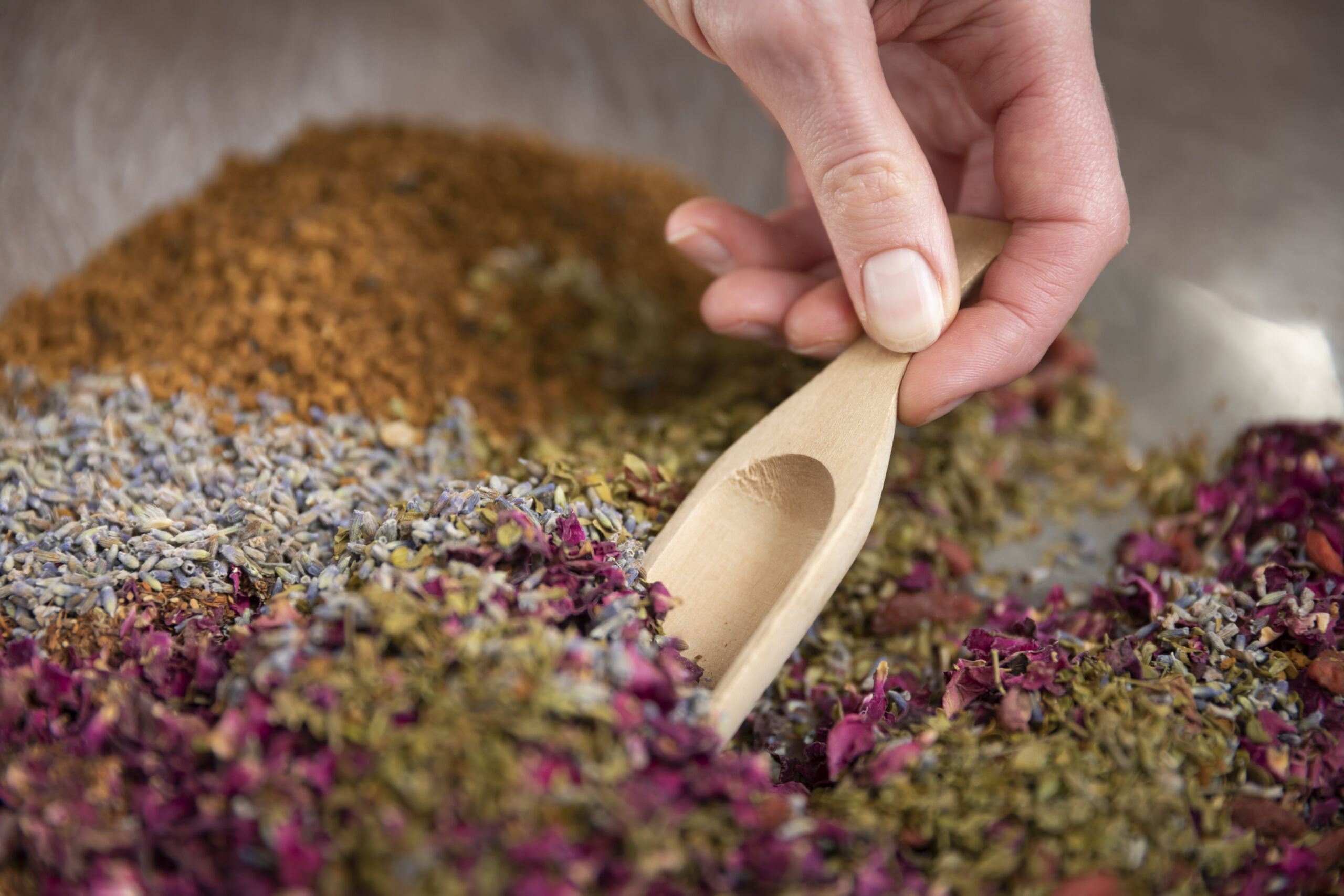
Very well stated. I’ve been taking vital adapt since I received a bottle at the Benefit for Mederi in Fairfield Ct. Gino said it best. You know your stuff.
I also use some of your other supplements. They are outstanding and adapt to my body extremely well.
I have promoted Mederi Center to many people.
I really feel blessed to have attended the gala, as I would not have learned about your work if I had’nt.
However as those of us that are enlightened and intuitive know. Nothing is just a coincidence!
What a thorough description of the virus and the adaptability of the plant kingdom to accommodate and react to the changes in another living entity. Thank you so much for your wisdom and for including photos of the specific plants that I’ve read about but could not visualize. Best wishes to you.